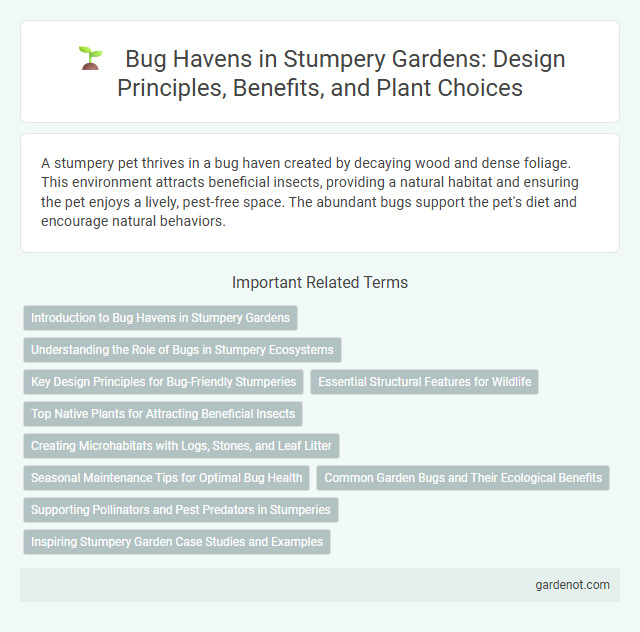A stumpery pet thrives in a bug haven created by decaying wood and dense foliage. This environment attracts beneficial insects, providing a natural habitat and ensuring the pet enjoys a lively, pest-free space. The abundant bugs support the pet's diet and encourage natural behaviors.
Introduction to Bug Havens in Stumpery Gardens
Bug havens in stumpery gardens provide essential habitats for beneficial insects, promoting biodiversity and natural pest control. These microhabitats consist of decaying wood, leaf litter, and crevices that shelter pollinators, predators, and decomposers crucial for ecosystem health. Integrating bug havens in stumperies enhances soil fertility and supports a balanced garden environment.
Understanding the Role of Bugs in Stumpery Ecosystems
Bugs play a crucial role in stumpery ecosystems by aiding in the decomposition of wood and organic matter, which enriches soil fertility and supports plant growth. These insects, including beetles, ants, and spiders, create microhabitats that promote biodiversity and balance within the stumpery environment. Understanding the interactions between bugs and decaying wood helps optimize the design and sustainability of stumperies as natural wildlife havens.
Key Design Principles for Bug-Friendly Stumperies
A bug-friendly stumpery emphasizes the use of diverse dead wood structures to create sheltered microhabitats essential for insects such as beetles, spiders, and woodlice. Incorporating varied sizes and orientations of logs, branches, and moss fosters moisture retention and temperature regulation, crucial for insect survival. Placement near native plants and avoiding chemical treatments further enhances biodiversity by providing abundant food sources and reducing toxic exposure.
Essential Structural Features for Wildlife
A stumpery designed as a bug haven incorporates essential structural features like decaying logs, layered bark, and varied wood textures to provide shelter, breeding grounds, and feeding habitats for diverse invertebrates. Hollow stems, crevices, and damp microhabitats support moisture-dependent species such as beetles and spiders, enhancing biodiversity within the garden ecosystem. Strategic placement of stumps and rotting wood in shaded, undisturbed areas maximizes habitat stability and encourages population growth of beneficial insects.
Top Native Plants for Attracting Beneficial Insects
Top native plants for attracting beneficial insects in a stumpery include goldenrod, milkweed, and joe-pye weed, which provide essential nectar and pollen sources. These plants support pollinators like bees and butterflies, as well as predatory insects such as ladybugs and lacewings that help control pest populations. Incorporating a diverse mix of native flora enhances the ecological balance and resilience of the bug haven within a stumpery garden.
Creating Microhabitats with Logs, Stones, and Leaf Litter
Creating microhabitats within a stumpery involves strategically placing logs, stones, and leaf litter to support diverse insect populations. Decaying wood provides shelter and breeding grounds for beetles and woodlice, while stones retain moisture for ground beetles and spiders. Leaf litter offers essential cover and foraging material, fostering a thriving bug haven that enhances garden biodiversity.
Seasonal Maintenance Tips for Optimal Bug Health
Regularly clear leaf litter and decaying wood to prevent mold and promote a healthy habitat for beetles and spiders in a stumpery. Ensure moisture levels remain balanced by watering during dry spells to support diverse insect populations. Seasonal pruning of surrounding plants improves air circulation, reducing pests and diseases that threaten bug health.
Common Garden Bugs and Their Ecological Benefits
Common garden bugs such as ladybugs, earthworms, and lacewings play a vital role in maintaining a healthy ecosystem within a stumpery by naturally controlling pest populations. These beneficial insects contribute to soil aeration, pollination, and organic matter decomposition, enhancing plant growth and biodiversity. Creating a bug haven in a stumpery encourages ecological balance and supports sustainable garden health.
Supporting Pollinators and Pest Predators in Stumperies
Stumperies provide an ideal habitat for beneficial insects, supporting pollinators such as bees and butterflies vital for ecosystem health. Decaying wood in stumperies fosters pest predators like ladybugs and ground beetles that naturally control harmful insect populations. This blend of shelter and food resources enhances biodiversity and strengthens garden resilience against pests.
Inspiring Stumpery Garden Case Studies and Examples
Bug havens in stumpery gardens provide essential habitats for beneficial insects such as ladybugs, beetles, and solitary bees, promoting natural pest control and pollination. Case studies reveal that integrating diverse stumpery designs with decaying logs, moss, and native wildflowers creates microhabitats that boost biodiversity and support local ecosystems. Examples from temperate gardens show increased insect activity and improved plant health, demonstrating the ecological value of stumperies as sustainable bug sanctuaries.
Bug haven Infographic

 gardenot.com
gardenot.com